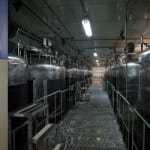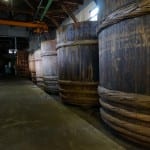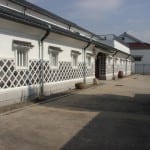 Tatenokawa Shuzo in Yamagata Prefecture has produced a sake with a one percent seimai buai. One. Percent.
Tatenokawa Shuzo in Yamagata Prefecture has produced a sake with a one percent seimai buai. One. Percent.
The product is named Komyo. Only 1500 bottles (720ml) were made, and they went on sale for 100,000 yen (circa US$960) each on Sake Day, October 1. See the Tatenokawa website for information on the retail outlets handling it.
They used a Yamagata rice called Dewa Sansan, which is known to be harder than most i.e. will stand up to more milling without cracking or breaking. Still, they must have done something to specifically select the grains that went into this, since they would need to be relative large to begin with. In order to achieve the one percent, the milling machines ran for two and a half months straight, for a total of about 1800 hours. For a daiginjo milled to 35 percent, this usually takes about 72 hours.
I do not currently have any more detailed information than the above. If that comes my way I will share it in time. Also, I do not expect to be able to taste it, with only 150 bottles made. I’m OK with that.
As a quick review that may be superfluous, the seimai buai refers to how much the rice was milled before brewing. The number expressed refers to the percentage of the rice grain by weight that remains after milling. So a 70 percent seimai buai means that the outer 30 percent was milled away, leaving the inner 70 percent remaining. A 40 percent seimai buai means that after milling only 40 percent of the original grain remains. And, of course, a one percent seimai buai means that a ridiculously whopping 99 percent of the grain was milled away, leaving only the inner one percent of each grain of rice remaining.
Why is the rice milled? Because fat and protein that can inhibit fermentation and lead to rough flavors resides in the outer portion of the grains of rice, and milling more and more removes those offending compounds. Of course, this can go too far in the opinion of many, and milling too much can potentially strip the resulting sake of character. Not necessarily, mind you; just potentially.
While surely most readers recall, to qualify for daiginjo the rice must be milled to a seimai buai of 50 percent. It can be taken further, of course. The erstwhile maximum was 35 percent, but from a several years ago a few producers pushed that envelope. We saw sake made with a 23 percent seimai buai, then 18 percent seimai buai. Until October 1, though, the maximum on the market was seven percent, of which there were three (Tatenokawa, Raifuku of Ibaraki, and Hakurakusei of Miyagi).
Keep in mind more milling is not better. Sure, it makes the sake lighter and more refined. But that might not be what one wants to drink. And even if your preference is lighter, more refined sake, more milling will lead to that to a certain degree. But once a certain threshold is crossed, milling beyond that will not make the sake any lighter or more refined.
While plenty of 35 percent sake exist, many folks in the industry say going beyond 40 percent is meaningless. Furthermore, if a brewer uses a method of milling rice 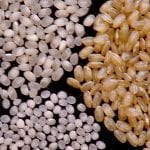 in such a way that it maintains the original oblong shape of each grain (rather than rounding them out), then a higher percentage of fat is removed with less milling. In that case, going much beyond 60 is moot, say some. (Such methods are called henpei seimai, or cho-henpai seimai, and were made well-known by Daishichi.)
in such a way that it maintains the original oblong shape of each grain (rather than rounding them out), then a higher percentage of fat is removed with less milling. In that case, going much beyond 60 is moot, say some. (Such methods are called henpei seimai, or cho-henpai seimai, and were made well-known by Daishichi.)
Regardless, going to one percent seimai buai has no real technical merit. So, why do it?
Because it’s something to talk about. It is newsworthy. It is good marketing. People will remember your brand. In that sense, it is brilliant.
And, at one percent, you cannot be outdone. Or so you’d think. But never say never in the sake world.
“““““““““““““““““““““““““““““““““““““““““““““““““““““““““““““`
Interested in learning much MUCH more about sake? Enroll in the Sake Professional Course in Las Vegas, December 4 – 6
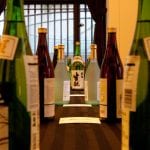 I will run the last Sake Professional Course of 2017 in Las Vegas at the MGM Grand Hotel from Monday, December 4, through Wednesday December 6.
I will run the last Sake Professional Course of 2017 in Las Vegas at the MGM Grand Hotel from Monday, December 4, through Wednesday December 6.
The content of this intensive sake course will be identical to that of the Sake Professional Course held each January in Japan, with the exception of visiting sake breweries. The course is recognized by the Sake Education Council, and those that complete it will be qualified to take the exam for Certified Sake Specialist, which will be offered on the evening of the last day of the course.
The cost for the three-day class, including all materials and sake for tasting, is US$899. Participation is limited and reservations can be made now to secure a seat; full payment is requested by November 15. You can read Testimonials from past participants here. You can see this information online here, and download it here. For reservations or inquiries, please send an email to sakeguy@gol.com.
“No Sake Stone Remains Left Unturned!”





